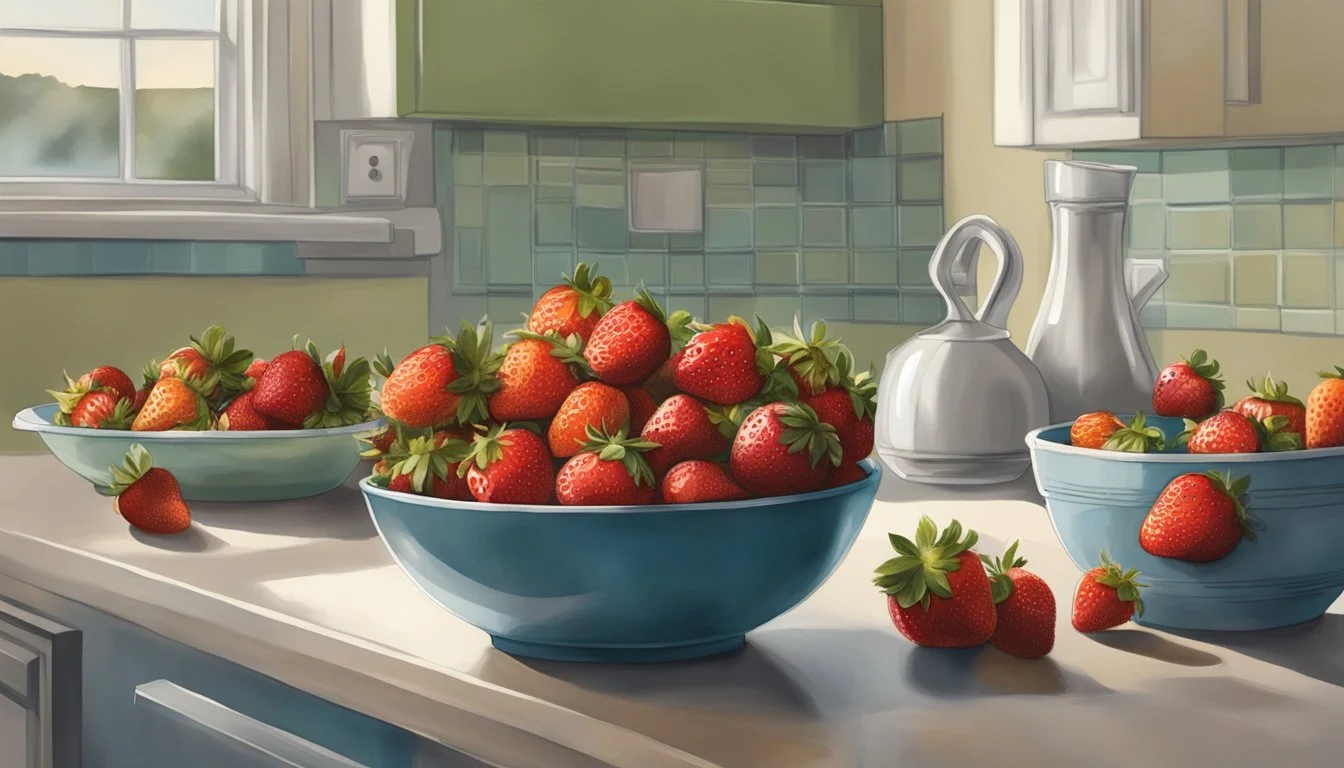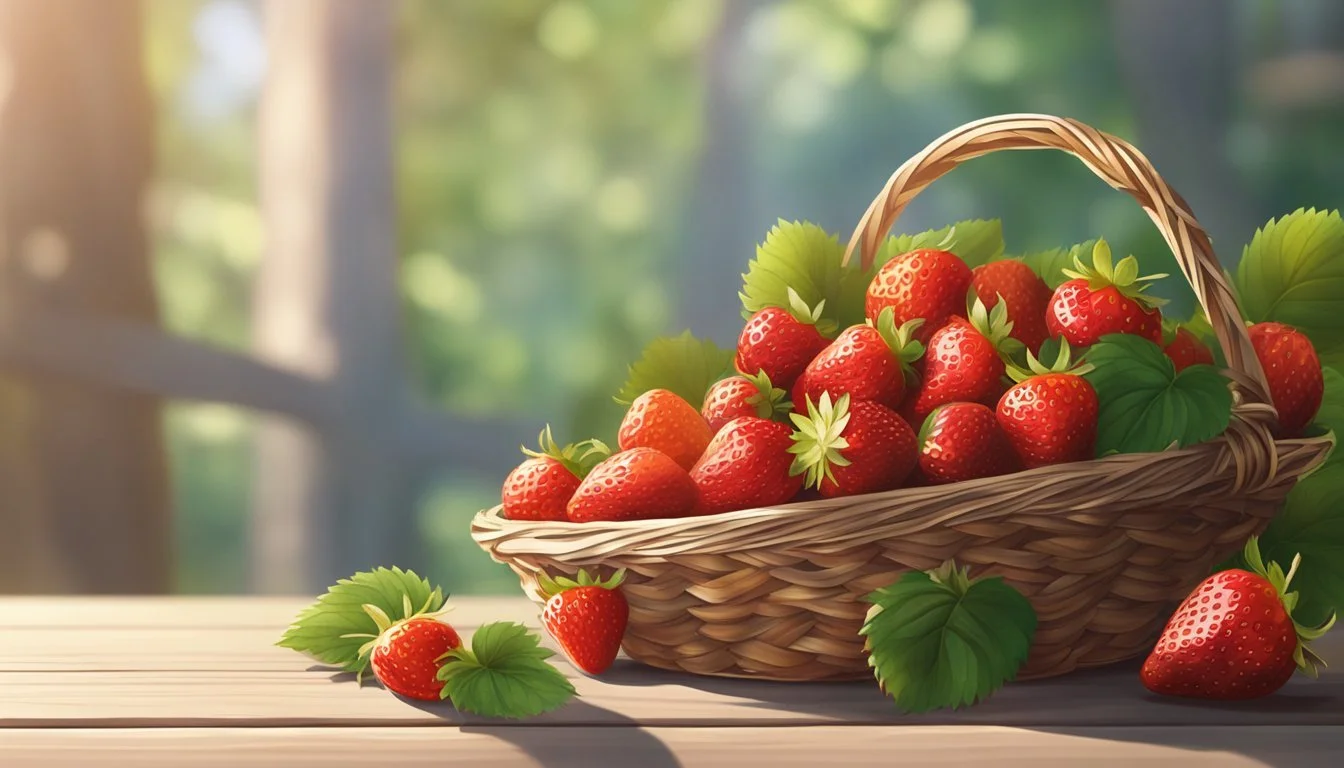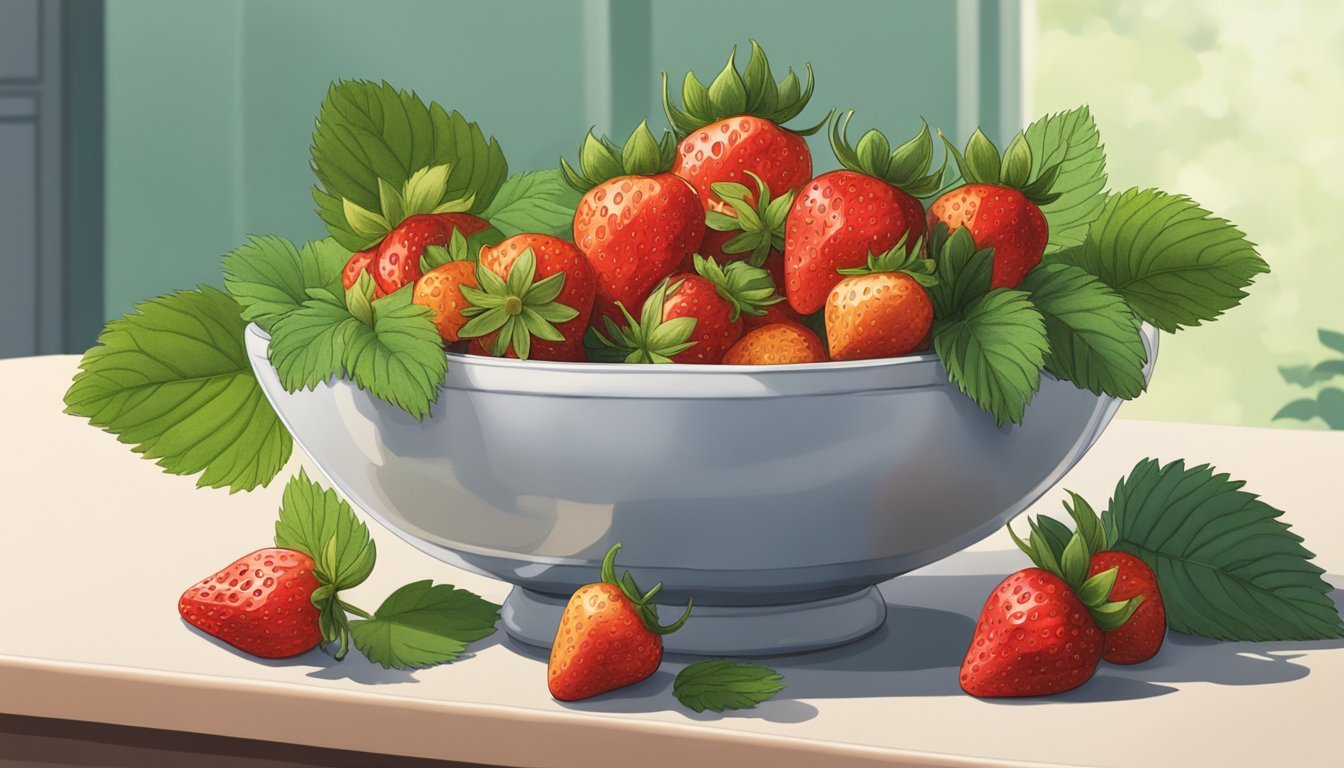How Long Do Strawberries Last?
A Guide to Storage and Shelf Life
Strawberries are a popular fruit known for their bright red color, sweet flavor, and juicy texture. Their shelf life, however, can be a concern for consumers looking to enjoy these berries at their freshest. Generally, strawberries last about three to seven days in the refrigerator when stored properly. Their longevity is influenced by factors such as their ripeness at the time of purchase, the storage method used, and the level of humidity they're exposed to.
To extend the freshness of strawberries, it is recommended to store them in the refrigerator in a manner that minimizes moisture and prevents mold growth. This involves using containers with adequate ventilation and lining them with paper towels to absorb excess moisture. Additionally, strawberries should be inspected regularly to remove any that have gone bad to prevent the spread of mold to the remaining fruit. The care taken in handling and storing strawberries can significantly impact their shelf life and overall quality.
Strawberry Basics
When discussing strawberry preservation and enjoyment, understanding their fundamental characteristics and seasonality is crucial.
Understanding Strawberries
Strawberries are delicate fruits known for their bright red color, juicy texture, and sweet, slightly tangy flavor. They are not only a popular food item due to their taste but also for their versatility in both culinary and dietary contexts. Typically, the structure of a strawberry is comprised of a fleshy edible part with tiny, outer seeds and a green leafy cap. When strawberries are fresh, their flavor and nutritional value are at their peak, which underscores the importance of proper storage to extend their freshness as long as possible.
Peak Strawberry Season
The peak season for strawberries varies depending on the geographical location, but it generally falls between late spring and early summer. During this time, strawberries are at their freshest, most flavorful, and most abundant. Consumers can expect strawberries to be:
Bright red: Indicating optimal ripeness and flavor.
Firm to the touch: A sign of freshness and quality.
The region's climate and farming practices can shift these timelines, but local farmers' markets and stores usually offer the best quality strawberries during this period. Outside of the peak season, strawberries are often available but may not possess the same level of freshness and flavor as those harvested at the ideal time.
Identifying Freshness
When selecting strawberries, it's crucial to consider indicators of freshness as well as signs of spoilage. These factors determine both the strawberries' current quality and their potential shelf life.
Freshness Indicators
Strawberries exhibit several signs that signal their freshness. Key indicators include:
Color: Fresh strawberries should have a bright, uniform red color. Any touch of green near the top suggests they are not fully ripe.
Firmness: They should be firm to the touch but not hard. Overly soft berries may be past their prime.
Gloss: Ripe strawberries have a natural shine. A dull appearance might indicate age.
Signs of Spoilage
It is equally important to recognize when strawberries have begun to spoil:
Mold: Look for any signs of white or green fuzzy spots which indicate mold growth.
Odor: Any off or fermented smell is a clear sign the strawberries are no longer good to eat.
Soft spots: Soft, mushy areas typically mean the strawberries are overripe or beginning to spoil.
Discoloration: Dark spots or patches are often an early sign of spoilage.
Storage Solutions
Selecting the proper storage techniques can drastically extend the shelf life of strawberries while maintaining their freshness. Knowing the right environment and materials to use is crucial for preventing spoilage.
Refrigeration Techniques
In the fridge, one should keep strawberries in a paper towel-lined container to absorb excess moisture. Storing them in a single layer prevents bruising and ensures even exposure to the cold environment. Using an airtight container is advantageous as it limits the amount of air the strawberries come into contact with, slowing down the deterioration process.
Freezing for Longevity
To freeze strawberries, one can initially spread them on a baking sheet in a single layer and then transfer them to an air-tight container or a resealable freezer bag. Freezing in a mason jar is another effective option. The key is to remove as much air as possible before sealing to prevent freezer burn and preserve the strawberries' texture and flavor for future use in strawberry recipes.
Alternative Storage Methods
Other techniques involve short-term solutions that can prolong freshness to a lesser extent compared to refrigeration or freezing. One method includes briefly soaking strawberries in a vinegar-water solution to eliminate mold spores and then thoroughly drying them before storage. Always ensure strawberries are dry and stored away from direct light or heat, as these factors can accelerate spoilage.
Preparation and Usage
When it comes to strawberries, their longevity hinges heavily on proper preparation. Preserving the freshness of berries starts with careful handling and can be extended by the strategic use of storage methods.
Prepping Strawberries
The first step in prepping strawberries is to ensure they remain unwashed until just before use to prevent moisture from hastening spoilage. When ready to prepare, wash the strawberries in water, then pat them dry gently with a towel. Strawberries can be sliced or hulled, depending on how they will be used. For cut strawberries, it's best to consume or use them within a few hours if left at room temperature, or store them in the fridge where they can last for 3 to 4 days.
Storage tips for fresh berries:
Store unwashed in the fridge with stems on to last 5 to 7 days.
Layer with paper towels in an airtight container to absorb excess moisture.
If sliced, consume quickly or store in the fridge for a shorter period.
Culinary Inspirations
Strawberries offer a burst of flavor to a variety of dishes from breakfast to dessert. They are a delightful addition to oatmeal, providing a fresh, juicy contrast to the grains. For those who adore the tangy-sweet combination, strawberries and rhubarb create a classic pie filling. In desserts, incorporating strawberries into cheesecake offers a rich and creamy texture with a fruity undertone, while blending them into ice cream yields a refreshing treat. Fresh berries can also act as a vibrant topper for cakes, adding both color and a natural sweetness.
Simple strawberry recipe ideas:
Dice strawberries for a fresh berry salad.
Puree and incorporate into dessert sauces or coulis.
Slice and add to yogurt or use as a smoothie ingredient.
By handling strawberries gently and using them thoughtfully in recipes, one can fully enjoy the range of culinary experiences they offer.
Extending Shelf Life
By managing conditions both before and during storage, one can significantly prolong the shelf life of strawberries while preserving their freshness and texture.
Before Storage
Selecting Quality Berries: The initial condition of strawberries greatly affects their longevity. One should choose plump, firm strawberries with no signs of mold or blemishes. It is important to keep the stems intact as they can help in retaining freshness.
Preparation With Care: To reduce spoilage, a gentle heat treatment can be effective. Immersing strawberries in a 125°F water bath for 30 seconds and then drying them can eliminate surface microbes. However, one must take care to not compromise the texture by over-soaking.
During Storage
Environment Control: Strawberries last longer when stored in cool conditions. Refrigeration is ideal, typically enabling them to stay fresh for 3 to 7 days. They should be kept whole to limit exposure to air and bacteria.
Container Choice: Use of an airtight container lined with paper towels absorbs excess moisture that could lead to quicker spoilage.
Avoiding Moisture: Ensuring the container is free from additional water can prevent a humid environment that fosters mold growth.
Preserving Methods: Some preserve freshness by using a sugar or vinegar solution. Though this can extend the life of strawberries, it may also alter their natural flavor profile, which should be considered when aiming to maintain the fruit's original taste and quality.
Purchase and Consumption Advice
When purchasing strawberries, selecting the freshest produce is crucial, as it directly affects both shelf life and taste. Proper storage upon arriving home will maximize the enjoyment and minimize waste.
Buying Strawberries
Season: The freshest strawberries are found during the local strawberry season. Buyers should check when strawberries are in peak season in their region.
Selection: Look for plump, firm strawberries with a bright red color. The leaves should be fresh and green. Avoid berries with signs of mold or blemishes.
Optimizing Consumption
Immediate Consumption: If planning to eat strawberries within a day or two, store them in the fridge unwashed in their original packaging or spread in a single layer on a tray.
Prolonged Freshness: To extend freshness, store strawberries in the refrigerator in an airtight container lined with paper towels. Do not hull or slice berries until ready to eat.
Advanced Storage Techniques
Exploring advanced storage techniques enables individuals to extend the shelf life of strawberries beyond the basic refrigerator storage. These methods involve creating an optimal environment that reduces decay and preserves freshness.
Vacuum Sealing
Vacuum sealing strawberries is an exceptional method to prolong their freshness. By removing air from the storage bag, one limits the exposure to oxygen, which is a key factor in the decomposition process. Strawberries can be vacuum sealed in plastic bags using a vacuum sealer. It is important to ensure the berries are dry before sealing to prevent ice crystal formation. They can then be stored in the fridge or freezer, the latter being suitable for long-term storage.
Dehydrating Strawberries
Dehydrating strawberries not only extends their shelf life but also concentrates the berry's natural sweetness. To dehydrate strawberries, one should:
Clean and slice the strawberries into even pieces.
Arrange them in a single layer on the dehydrator trays.
Follow the dehydrator's instructions, typically dehydrating at 135°F (57°C) for 8 to 10 hours.
After dehydrating, the strawberries should be stored in airtight containers with lids, preferably in a cool, dark place to maintain their quality.
Canning and Preserving
Canning and preserving strawberries allows them to be enjoyed throughout the year. This method involves:
Sterilizing jars and lids in boiling water.
Filling the sterilized jars with strawberries, which can be left whole, sliced, or crushed, depending on one's preference.
Covering the strawberries with a hot syrup or natural juices and leaving the appropriate headspace.
Applying the lids and processing the jars in a water bath or pressure canner according to safe canning practices.
After cooling, the jars should be stored in a cool, dark place. Canning retains the fruit's taste and texture, while protecting it from spoilage. When done correctly, canned strawberries can last for up to a year. It's essential to use a dish towel to provide a cushion between the hot jars and the cooling surface to prevent jar breakage.
Thawing and Post-Freezing Care
Maintaining the quality of strawberries after freezing requires careful thawing and storage strategies. Proper techniques ensure that strawberries retain their texture and flavor when defrosted and used.
Defrosting Strategies
Cold Water Thaw: To defrost strawberries quickly and maintain their integrity, one can place them in a leak-proof bag and submerge it in cold water. It's important to change the water every 10-15 minutes, and the process typically takes 30 minutes to an hour.
Microwave Thawing: For an even quicker method, strawberries can be defrosted in the microwave. Using the defrost or low power setting, this method can thaw the berries in under five minutes. Care should be taken to avoid overheating, which can cause the strawberries to become mushy.
When storing strawberries, whether they are fresh or previously frozen, it is recommended to keep them at a consistent cold temperature. If the berries have been thawed in cold water or a microwave, they should be consumed within the same day for optimal freshness and safety. Defrosting strawberries at room temperature is not advised, as it can lead to bacterial growth and spoilage.
Reducing Strawberry Waste
The key to reducing strawberry waste lies in proper storage and the innovative use of ripe or near-spoilage strawberries in a variety of recipes.
Creative Utilization
When strawberries become overly ripe but are not yet spoiled, they can be transformed into an array of culinary delights. One can use these strawberries to make jams, which not only extend the fruit's usability but also serve as a delicious way to sweeten breakfast items and desserts. Here's a succinct list to inspire resourceful uses of ripe strawberries:
Jams and preserves: Cooking strawberries with sugar can create delightfully sweet spreads.
Smoothies: Blend overripe strawberries with other fruits and yogurt for a nutritious drink.
Dessert toppings: Mash the strawberries and add them to ice cream or yogurt.
Baking: Incorporate ripe strawberries into muffins, cakes, or pastries.
Sauces: Ripe strawberries can be reduced into sauces for savory dishes.
Freezing: Prepare and freeze strawberries for future smoothies or baked goods.
These methods not only decrease waste but also add flavorful twists to meals and treats, showcasing the versatility of strawberries in the culinary world.







